
The year 1956 marked the intersection of two Winchester innovations, rifle and cartridge. The heavy hitter Model 70 Winchester, replacing the Model 54 in 1936-1937, was chambered for the 375 H&H. Available in standard and Super Grade version, the 375 H&H after 1937 was supplied with a 25″ barrel.
Unfortunately, people lacking in refined hunting skills had the hunted scoring more points than the hunters. Additionally, some African hunting game laws written around near cannonball shooting black powder rifles required the use of .40 caliber and above on elephant, rhino and cape buffalo. Subsequently, the Winchester stepped up and the Model 70 Super Grade African was added to the Winchester catalogue, chambered for the then new 458 Winchester Magnum.
 And so it followed, that in 1956, I was sitting in the back row of Miss Conahan’s English class, taking cover behind a large textbook, partially open and propped up on end on my desk top, reading the new issue of Guns and Something or Other. There was a great story about the then new Winchester Model 70 African, chambered for the then new 458 Winchester Magnum, complete with photos of hunter standing in front of felled elephant with lots of smiling locals. This passage should provide great insight into my life long appreciation of hunting firearms and my haphazard approach to the English language.
And so it followed, that in 1956, I was sitting in the back row of Miss Conahan’s English class, taking cover behind a large textbook, partially open and propped up on end on my desk top, reading the new issue of Guns and Something or Other. There was a great story about the then new Winchester Model 70 African, chambered for the then new 458 Winchester Magnum, complete with photos of hunter standing in front of felled elephant with lots of smiling locals. This passage should provide great insight into my life long appreciation of hunting firearms and my haphazard approach to the English language.
The appeal of this combination can be found in the early 1900 through mid century stories of hunting in Africa, six month long safaris, celebrity hunters, famous professional hunters and so many close calls. Something on the order of, “We tracked the big rogue bull to the watering hole and closed within 25 yards. Heavy in ivory, he raised his enormous head at our approach, fanned his ears wide and trumpeting an earth shaking charge. My first shot struck behind the right eye and fed the beast’s fury. He kept coming. A second shot, struck his chest, exploded his heart and buckled his legs before he slid within five feet of where I stood”.
The appeal was in the John Henry Patterson, Joseph Conrad, John Taylor like story telling; heat, sweat, tsetse flies, in camp for months, hunting the most dangerous game. Food for the imagination for an eleven year old who went to school, worked after school and summers in the family business and lived in the least wildlife environment in the world, New Jersey. If I only owned that rifle, I could go on safari and become a legend like… W.D.M. Bell, but that never happened because the 458 Winchester Magnum Model 70 eluded me… until now.
The current heavy caliber Winchester Model 70 is the African Express. In addition to the subject rifle’s chamber, it is also available in 416 Remington and 375 H&H magnums.
|
Winchester Model 70 Safari Express |
|
| Manufactured | Viana Portugal |
| Item# | 535204144 |
| Type | Bolt Action |
| Caliber | 458 Winchester Magnum |
| Capacity | 3+1 |
| Barrel Length | 24″ |
| Rifling | 1:14 RH |
| Weight | 9 Lbs 0 Oz |
| Overall Length | 44 3/4″ |
| Stock | Grade I Black Walnut |
| Barreled Action | Matte Blue Steel |
| Length of Pull | 13 3/4″ |
| Drop at comb | 1/2″ |
| Drop at heel* | 1/2 “ |
| Sights | Adj Rear – Hooded Front |
| Scope | Drilled and Tapped |
| Trigger Pull | 4 Lbs. 2 Oz. Adjustable |
| Safety | Wing Three Position |
| U.S. MSRP | $1,559.99 |
There are not too many differences between the current Model 70 Safari Express and the 1956 Model 70 African. The early version had a high comb Monte Carlo buttstock, 25″ barrel, three folding blade rear express sights.
Both early and new generations have stock dual cross bolts, banded front sling attaching point, and controlled round feed with claw extractor to prevent those awkward moments when large and dangerous quarry and hunter do not share a common goal. Both have a blade type ejector.
The current generation is probably more of a hunter’s rifle. The Safari Express has a satin finished, straight stock with minimal drop at the comb and heel to better manage recoil and to provide improved eye to scope alignment The steel parts, barreled action and bottom metal are matte finished instead of more reflective gloss or satin. The single blade express sight, ramped and hooded front sight and drilled and tapped receiver are a better fit for intended applications. It is designed to be a hard working rifle that will hold up under the recoil of the big .45 caliber magnum.
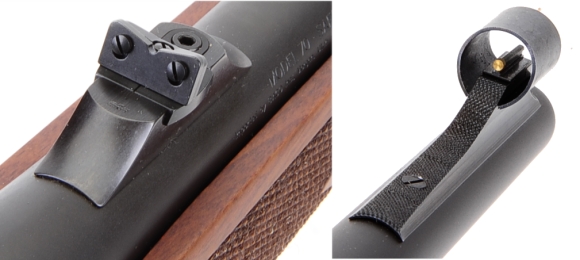
The wide V and precision shooting notch and really nicely done front sight are an a good match for fast target acquisition and critical aiming; stout, non glare hunting sights. The sight picture has three reference surfaces for quick alignment.

The top of the Model 70’s forged steel receiver is drilled and tapped for scope mounts. The wing safety is three position: safe with bolt locked in battery, safe with operable bolt for chamber clearing and, finally, fire. The bolt handle tucked in above the know to reduce the chance of getting snagged, the bolt knob is knurled for a non-slip surface. Cross bolts locate to twin action integral recoil lugs to bolster the stock against heavy magnum recoil.
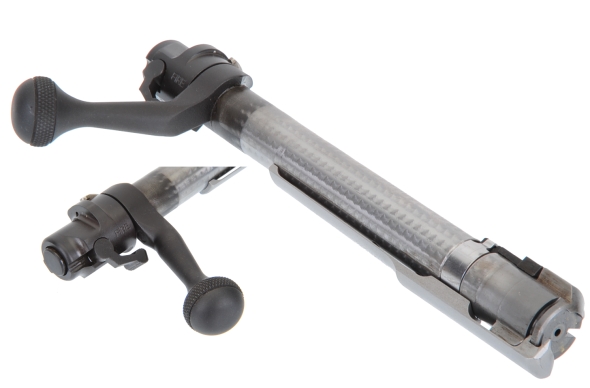
The bolt is a twin lug with 90º lift. It has a controlled feed claw extractor and a gas block behind the left lug. The shape of the bolt knob is comfortable in use, the knurling makes for a useful non-slip surface and the jeweled bolt body is a nice touch.
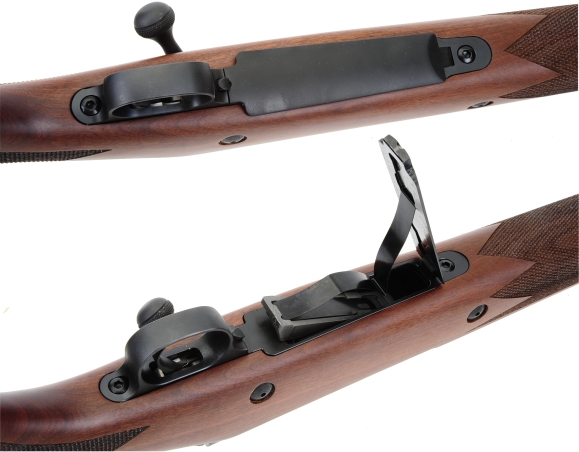
The bottom metal is one piece, further reinforcing and stiffening the barreled action and stock assembly. The piece is steel, as are the floor plate, magazine box and follower. Very nicely done at a time when companies are cost reducing with poly and aluminum substitutes. The M.O.A. Trigger System has virtually zero take-up, zero creep and zero overtravel and is adjustable for pull.
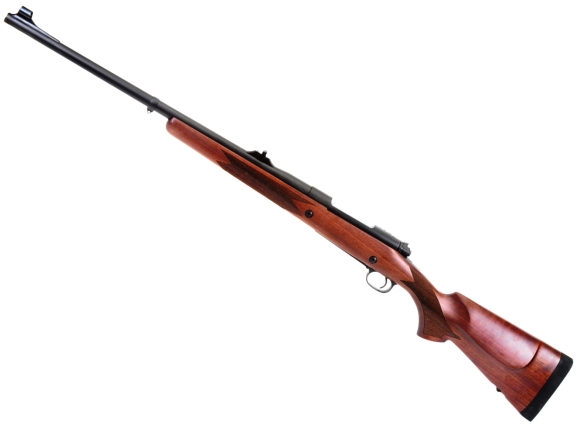
The cheekpiece provides support without smacking the cheekbone under recoil. The forearm is more full than would be the case with a lighter caliber sporter. In a rifle like this, the 9 lbs weight is beneficial and the wider forearm easily accommodates the full floating heavy contour barrel. The modern Decelerator recoil pad is appreciated. Good looking firearm.
The 458 Winchester Magnum as one of a series…
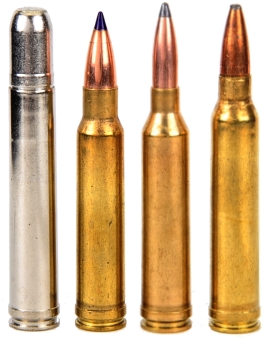 Above, left to right – 458 Winchester Magnum, 338 Winchester Magnum, 264 Winchester Magnum, and 300 Winchester Magnum.
Above, left to right – 458 Winchester Magnum, 338 Winchester Magnum, 264 Winchester Magnum, and 300 Winchester Magnum.
On the heels of the Winchester Model 70 African in 458 Winchester Magnum came two 1958 cartridge introductions, the 338 Winchester Magnum and the 264 Winchester Magnum, which found their way respectively into the 1960 Winchester Alaskan and Winchester Westerner. The last in the series of 30-06 length action belted cartridge was the 300 Winchester Magnum that joined the line up in 1963, a replacement for the fading in popularity 300 H&H. It did not receive a Model 70 model dedicated in its honor, which is curious because it is clearly the runaway popular leader of the pack.
Over the years, I have owned and hunted with the Alaskan in both 338 Winchester Magnum and 375 H&H Magnum. I have owned and hunted with the Westerner in 264 Winchester Magnum. I have owned and hunted with Model 70 Winchesters in 300 Winchester Magnum. I have owned Winchester Model 70 Safari or Express rifle in 375 H&H and 416 Remington, but I have never previously spent time with this model in 458 Winchester, so it remained on my list of rifles I wanted to experience. For that reason, I hope you can bear with me while I peek and poke and drone on at and about this combination, to my satisfaction.
The 458 Winchester as a big gun standard
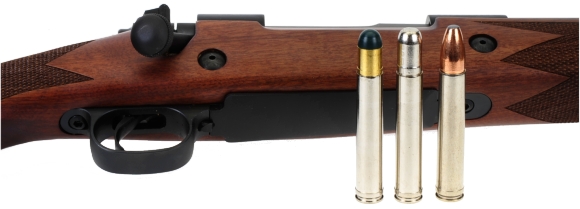
Above, three Federal Cartridge loads for the 458 Winchester Magnum, L-R Federal Premium Safari Cape-Shok: 500 grain Woodleigh Hydro Solid, 500 grain Trophy Bonded Sledgehammer Solid, 500 grain Swift A-Frame.
Pushing a 500 grain bullet 2050 fps, generating 4665 ft-lbs of muzzle energy is not the product of a trivial cartridge. Loaded with the proper bullet, the 458 Winchester Magnum can competently drop the largest game and, for people who can handle the recoil, it is a sure stopper for dangerous game with less body mass. Are there more powerful cartridge? Sure, many of them 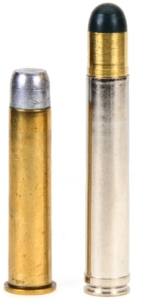 appear on Real Guns; 450 Rigby, 460 Weatherby, 500 Jeffery… but more than enough is just excessive and some of these are just downright unpleasant to shoot.
appear on Real Guns; 450 Rigby, 460 Weatherby, 500 Jeffery… but more than enough is just excessive and some of these are just downright unpleasant to shoot.
I love the 45-70 cartridge. It can be loaded up to significant performance no one would have ever imagined when it was created in 1873. Some of my Ruger No. 1 handloads are truly attention getters. Still, unlike some folks claim, it is not almost as powerful as the 458 Winchester Magnum. The difference can be best illustrated by the 458 Winchester Magnum’s ability to push a 500 grain bullet approximately 30% faster than the 45-70 and the bullet’s kinetic energy increases at the square of its velocity.
| Cartridge | Capacity H2O Grains |
Bullet Grains |
24″ Barrel MV FPS |
24″ Barrel ME Ft-Lbs |
| 45-70 Govt |
79.0 | 500 | 1625 | 2931 |
| 458 Win Mag | 95.0 | 500 | 2050 | 4665 |
How does the 458 Winchester Magnum compare to other magnum chambers offered for the Winchester Model 70 Safari Express? Glad you asked.
 Pictured Left, L-R, 375 H&H Magnum, 416 Remington Magnum, 458 Winchester Magnum.
Pictured Left, L-R, 375 H&H Magnum, 416 Remington Magnum, 458 Winchester Magnum.
| Cartridge | H2O Grains Capacity |
Case Length” |
Cartridge Length” |
Bullet Weight Grains |
MV FPS |
ME Ft-Lbs |
| 375 H&H | 95 | 2.850 | 3.600 | 300 | 2440 | 3966 |
| 416 Rem Mag | 107 | 2.850 | 3.600 | 400 | 2400 | 5115 |
| 458 Win Mag | 95 | 2.500 | 3.340 | 500 | 2100 | 4895 |
The parent case for all pictured is the 1912, full length 375 Holland & Holland belted Magnum. For heavy work, it is typically loaded with a 300 grain bullet.
The 416 Remington of 1988, is also a full length magnum, made by opening the 375 H&H Magnum case to accept a 0.416″ bullet and blowing out most of the case taper. Heavy work is usually associated with a 400 grain bullet.
The 1956 458 Winchester Magnum was made by shortening the 375 H&H Magnum case, removing much of the taper and opening it to accept a 0.458″ bullet. Heavy work is usually attributed to a 500 grain bullet weight. Where the 458 Winchester can be chambered in a standard 30-06 Springfield length action, the others require a long or magnum length action.
Is the 416 Remington Magnum more powerful than the 458 Winchester Magnum? Only by kinetic energy measurement as the larger diameter and heavier weight 458 Winchester Magnum bullet generates higher momentum and has a higher KO Factor. The 416 Remington generates 4.25 pound-seconds of momentum and a Taylor KO factor of 57. The 458 Winchester Magnum generates 4.25 pounds seconds of momentum and a Taylor KO Factor of 69. Usually, this interprets into greater penetration along with full bullet expansion. I do not think a struck animal could differentiate. Both cartridges are available in factory loads each with dies and components readily available.
But, Joe, is there a point to all of this?
The 458 Winchester has a reputation for not delivering factory rated velocity. Could be that the Winchester barrel has been shortened one inch, could be factory ammunition conservative loading, could be handloading without current powder types available. It would also seem that the 458 Winchester Magnum could deliver solid lighter bullet performance, lending range to the cartridge and broader firearm utility.
Subsequently, the plan is to burn up some factory ammo checking velocity and accuracy. Then burn up some handloads in different weights to see how that longer range shooting works out. I will be back shortly with some conclusions. Some may even be correct.
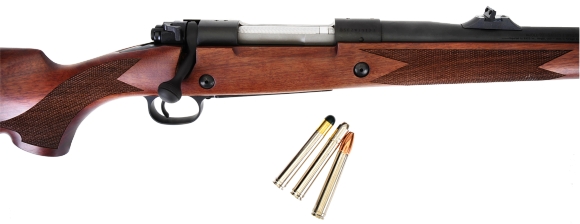

Email Notification